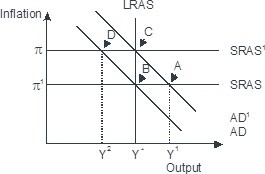If a chair can be sold for $20 and it takes a worker two hours to make a chair, the marginal revenue product of this worker is
A. $2 per hour.
B. $20 per hour.
C. $10 per hour.
D. $5 per hour.
Answer: C
You might also like to view...
Based on the figure below. Starting from long-run equilibrium at point C, a decrease in government spending that decreases aggregate demand from AD1 to AD will lead to a short-run equilibrium at__ creating _____gap.
A. B; no output B. D; an expansionary C. B; recessionary D. D; a recessionary
For the recessions in the United States since the 1950s,
A) unemployment falls on average by 2 percentage points during the 12 months after a recession begins. B) unemployment rises on average about 5 percentage points during the 12 months after a recession begins. C) cyclical unemployment has been non-existent. D) unemployment rises on average by about 1.2 percentage points during the 12 months after a recession begins.
The Bretton Woods agreement was signed at Bretton Woods, New Hampshire, in
A) 1944. B) 1929. C) 1970. D) 1973.
In cases where no employer-specific skills are required for a particular job, a long-term relationship between an employer and an employee is unlikely
Indicate whether the statement is true or false